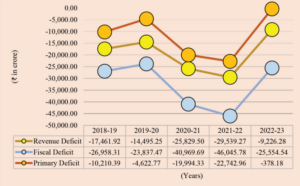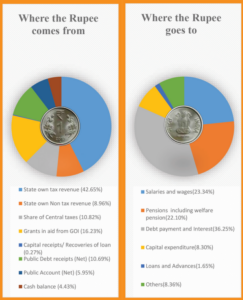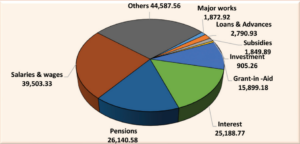Kerala's Gross State Domestic Product (GSDP) has exhibited robust growth, averaging 8.69 percent from 2018-19 to 2022-23. This growth is indicative of Kerala’s economic vitality. However, the state’s fiscal position remains under pressure due to a persistent gap between receipts and expenditures.
Published Oct 23, 2024 | 7:30 PM ⚊ Updated Oct 23, 2024 | 7:30 PM

Kerala PSUs bleed, off-budget debt rises. Representative Image. (iStock)
The Kerala State Finances Audit Report from the Principal Accountant General (Accounts & Entitlement), for the year ended 31 March, 2023 paints a complex picture of the state’s fiscal health.
The Gross State Domestic Product (GSDP) has exhibited robust growth, averaging 8.69 percent from 2018-19 to 2022-23. This growth is indicative of Kerala’s economic vitality.
However, the state’s fiscal position remains under pressure due to a persistent gap between receipts and expenditures. Revenue receipts have increased significantly, with tax revenue growing by 18.47 percent in 2022-23.
Despite this, the state’s expenditure has outpaced revenue, leading to rising fiscal deficits.
The government’s reliance on grants-in-aid from the Central government has also increased, highlighting the need for greater fiscal autonomy.
Kerala’s GSDP grew 11.95 percent in 2022-23 compared to the previous fiscal year, signalling economic recovery.
The revenue receipts also recorded an encouraging 13.79 percent growth, with the state’s tax revenue registering a sharp 23.36 percent increase.
However, the heavy reliance on grants-in-aid from the Union government — rising from 12.27 percent of revenue receipts in 2018-19 to 20.63 percent in 2022-23 — underscores the state’s growing dependence on federal support.
Despite this, the shrinking revenue deficit from ₹29,539 crore in 2021-22 to ₹9,226 crore in 2022-23 represents a positive step.

Trends in deficit
courtesy – State Finances Audit Report
However, Kerala remains constrained by committed expenditures, leaving little room for investment in priority sectors and capital infrastructure.
The state’s total expenditure in 2022-23 decreased by 2.75 percent from the previous year to ₹1.58 lakh crore, driven by a 2.89 percent reduction in revenue expenditure.
However, the bulk of the expenditure (nearly 89-92%) remains allocated towards operational and recurring costs, such as salaries, pensions, and interest payments.
In 2022-23, committed and inflexible expenditures alone constituted 76.53 percent of the total revenue expenditure, limiting fiscal flexibility.

Composition of resources and
Application of resources
courtesy – State Finances Audit Report
Moreover, capital expenditure — a key driver of long-term growth — accounted for only 8.82 percent of total spending in 2022-23.
This translates to just 2.12 percent of total borrowings being allocated towards developmental activities, raising concerns about Kerala’s ability to sustain future economic growth.
Although Kerala reduced its fiscal deficit to ₹25,554 crore (2.44% of GSDP) in 2022-23 from ₹46,045 crore the previous year, the growing reliance on borrowings is troubling.
The public debt-GSDP ratio increased from 20.07 percent in 2018-19 to 24.14 percent in 2022-23, reflecting a significant rise in liabilities.
Adding to the concern are off-budget borrowings amounting to ₹8,058 crore, taken through Public Sector Undertakings (PSUs).
These borrowings, although not reflected in the state’s consolidated fund, add to the government’s repayment burden.
Including these, Kerala’s overall debt stands at 38.23 percent of GSDP, well above the 34.5 percent threshold outlined by the Fiscal Responsibility and Budget Management (FRBM) Act.
Subsidies, though a relatively small component of Kerala’s budget, have shown a fluctuating trend.
In 2022-23, subsidies accounted for ₹1,847 crore, or 1.3 percent of revenue expenditure.
However, Kerala’s larger fiscal burden stems from committed expenditures such as salaries, pensions, and interest payments. These expenditures, which grew at an average rate of 7.28 percent, accounted for over 63 percent of revenue expenditure in 2022-23.

Head wise expenditure
courtesy – State Finances Audit Report
The rising share of such inflexible commitments leaves little room for developmental spending. Any meaningful fiscal consolidation will require rationalising these recurring expenditures and shifting focus towards capital creation.
The report highlights that Kerala has extensively relied on off-budget borrowings through two key institutions — KIIFB (Kerala Infrastructure Investment Fund Board) and KSSPL (Kerala Social Security Pension Limited).
Off-budget borrowings are extra-budget borrowings that offer the government a way to finance expenditures while keeping the debt off the books. The government asks another public institution to borrow on its behalf, and so the loan is not accounted for in the fiscal deficit.
This helps the government keep its fiscal deficit within acceptable limits, but increases the opacity of government finances and compromises accountability.
Kerala’s off-budget borrowings, meant to fund large infrastructure projects and welfare pensions, have quietly added a significant debt load to the state.
The report highlighted that the combined off-budget debt from both KIIFB and KSSPL amounts to ₹29,475.97 crore.

Entity-wise details of off-budget borrowings
courtesy – State Finances Audit Report
If these hidden liabilities are factored in, Kerala’s debt-to-GSDP ratio rises to 38.23 percent, exceeding the fiscal target of 34.50 percent.
This raises concerns about transparency and fiscal sustainability, as the borrowings add pressure to the state exchequer without being reflected in the official budget.
Meanwhile, the government argues that KIIFB’s borrowings are not off-budget debt but part of its “agency function.” KIIFB was established in 1999 as the principal funding arm of the state government, to channelise funds for large, critical infrastructure projects of the government.
However, the fact remains that both KIIFB and KSSPL operate without independent revenue streams, shifting the debt burden to the state — a move critics say undermines fiscal discipline.
The report also revealed alarming financial distress among Kerala’s Public Sector Undertakings (PSUs), with over half of the working units grappling with significant losses.
It highlights the urgent need for structural reforms to prevent further strain on the state’s resources, raising questions about the sustainability of several PSUs.
Out of 131 working PSUs, 77 units have collectively accumulated losses amounting to ₹18,026.49 crore.
Among them, 44 PSUs reported complete erosion of their net worth, which now stands at a negative ₹11,227.04 crore, despite an equity infusion of ₹5,954.33 crore from the government.
The report also criticises the PSUs for poor financial discipline.
Only 16 PSUs, representing 12.21 percent of working units, submitted their financial statements for 2022-23 within the stipulated timeframe.
Meanwhile, 270 accounts from 115 PSUs were pending finalisation, hampering timely oversight and transparency.
The report urges the state government to take swift and decisive steps to stem the financial losses in these PSUs.
The report offers the state government a few recommendations, including:
In short, the report paints Kerala’s fiscal journey as a complex challenge.
On one hand, the state has made strides in reducing revenue and fiscal deficits, but on the other, it remains trapped in a cycle of rising debt, high committed expenditure, and limited flexibility in its budget. It must address the underlying fiscal challenges to ensure a strong and resilient economy for the future.
(Edited by Rosamma Thomas)
